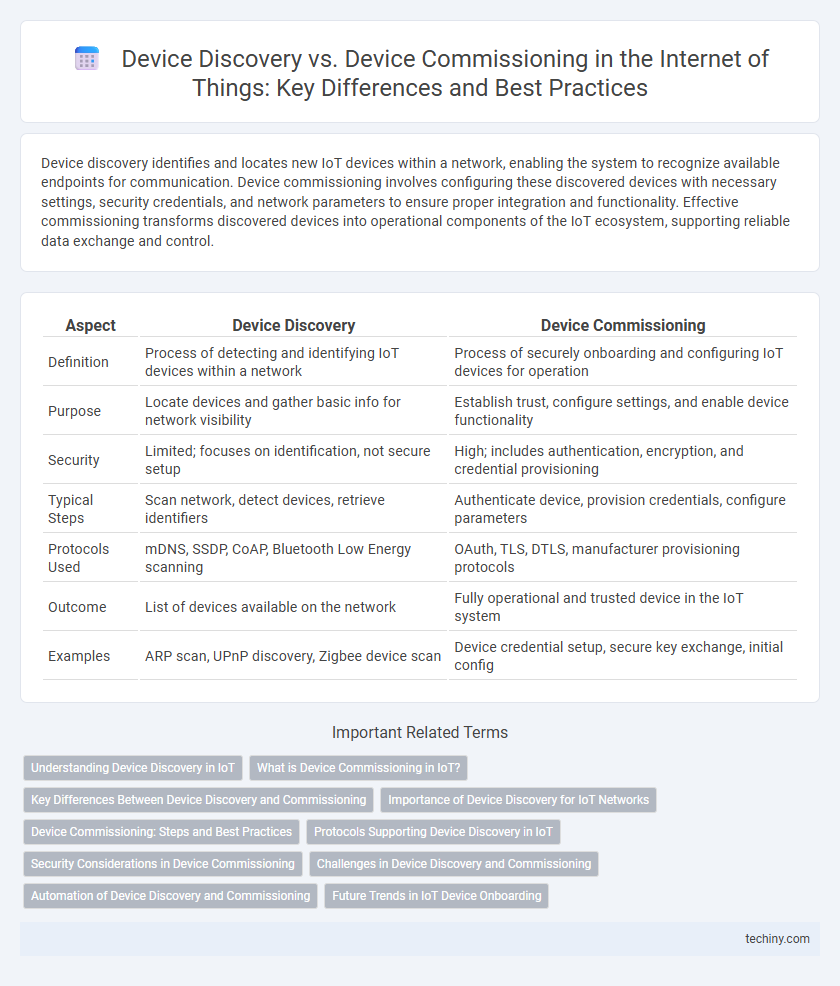Device discovery identifies and locates new IoT devices within a network, enabling the system to recognize available endpoints for communication. Device commissioning involves configuring these discovered devices with necessary settings, security credentials, and network parameters to ensure proper integration and functionality. Effective commissioning transforms discovered devices into operational components of the IoT ecosystem, supporting reliable data exchange and control.
Table of Comparison
| Aspect | Device Discovery | Device Commissioning |
|---|---|---|
| Definition | Process of detecting and identifying IoT devices within a network | Process of securely onboarding and configuring IoT devices for operation |
| Purpose | Locate devices and gather basic info for network visibility | Establish trust, configure settings, and enable device functionality |
| Security | Limited; focuses on identification, not secure setup | High; includes authentication, encryption, and credential provisioning |
| Typical Steps | Scan network, detect devices, retrieve identifiers | Authenticate device, provision credentials, configure parameters |
| Protocols Used | mDNS, SSDP, CoAP, Bluetooth Low Energy scanning | OAuth, TLS, DTLS, manufacturer provisioning protocols |
| Outcome | List of devices available on the network | Fully operational and trusted device in the IoT system |
| Examples | ARP scan, UPnP discovery, Zigbee device scan | Device credential setup, secure key exchange, initial config |
Understanding Device Discovery in IoT
Device discovery in IoT refers to the process of identifying and locating connected devices within a network automatically, enabling seamless integration and communication. This process often employs protocols like mDNS, SSDP, or Bluetooth Low Energy scanning to detect new devices and their capabilities without manual input. Efficient device discovery is crucial for scaling IoT ecosystems, ensuring devices are recognized quickly for configuration, management, and data exchange.
What is Device Commissioning in IoT?
Device commissioning in IoT refers to the process of securely enrolling and configuring new devices to join a network, ensuring proper authentication, authorization, and integration with existing systems. It involves setting up device credentials, network settings, and operational parameters to enable seamless communication and management within the IoT ecosystem. Effective commissioning enhances device security, simplifies management, and optimizes overall network performance.
Key Differences Between Device Discovery and Commissioning
Device discovery in the Internet of Things (IoT) involves identifying and locating devices within a network, while device commissioning refers to configuring and activating these devices for operational use. Key differences include that discovery is primarily about detecting device presence and capabilities, whereas commissioning establishes secure communication, settings, and integration with other systems. Discovery is often automated and passive, but commissioning requires deliberate action to validate device authenticity and ensure proper functionality.
Importance of Device Discovery for IoT Networks
Device discovery is crucial for IoT networks as it enables automatic identification and integration of new devices, ensuring seamless connectivity and real-time data exchange. This process supports scalable IoT deployments by reducing manual configuration efforts and minimizing potential errors during network expansion. Efficient device discovery improves network responsiveness and security by continuously monitoring device presence and status.
Device Commissioning: Steps and Best Practices
Device commissioning in the Internet of Things (IoT) involves securely connecting and configuring devices to a network, ensuring they operate correctly within the system. Key steps include device identification, authentication, network association, configuration of settings, and verification of functionality. Best practices emphasize secure credential management, automated onboarding processes, and continuous monitoring to maintain device integrity and performance throughout its lifecycle.
Protocols Supporting Device Discovery in IoT
Device discovery in IoT relies heavily on protocols such as mDNS (Multicast DNS), SSDP (Simple Service Discovery Protocol), and CoAP (Constrained Application Protocol) for detecting and identifying devices within a network. These protocols enable seamless communication and interoperability by broadcasting device presence and capabilities without requiring manual configuration. Device commissioning, by contrast, involves securely onboarding devices after discovery, ensuring authentication and configuration typically through protocols like OCF (Open Connectivity Foundation) or LwM2M (Lightweight Machine-to-Machine).
Security Considerations in Device Commissioning
Device commissioning in the Internet of Things prioritizes security by ensuring authenticated access and secure key exchanges during device onboarding, unlike device discovery which primarily identifies available devices. Robust encryption protocols and mutual authentication mechanisms mitigate risks of unauthorized access and man-in-the-middle attacks during commissioning. Secure commissioning frameworks enforce device identity verification and trust establishment to maintain the integrity of IoT ecosystems.
Challenges in Device Discovery and Commissioning
Device discovery in the Internet of Things (IoT) faces challenges like device heterogeneity, dynamic network topologies, and security vulnerabilities during identification. Device commissioning struggles with ensuring secure authentication, seamless configuration across diverse devices, and minimizing manual intervention to reduce deployment time. Both processes require robust protocols to address scalability, interoperability, and resistance to cyber-attacks for efficient IoT network expansion.
Automation of Device Discovery and Commissioning
Automation in device discovery within the Internet of Things (IoT) accelerates identification and network integration of devices using protocols like mDNS and SSDP. Device commissioning automation configures, authenticates, and activates IoT devices, often leveraging cloud platforms and machine learning for seamless onboarding. Streamlining these automated processes enhances operational efficiency, reduces manual errors, and supports scalable IoT deployments.
Future Trends in IoT Device Onboarding
Future trends in IoT device onboarding emphasize automated device discovery leveraging AI-driven network scanning to improve accuracy and reduce deployment time. Enhanced security protocols during device commissioning integrate blockchain and zero-trust frameworks to ensure device authenticity and data integrity. The convergence of edge computing and cloud services is set to streamline onboarding processes, enabling scalable and efficient device management in diverse IoT ecosystems.
Device Discovery vs Device Commissioning Infographic

 techiny.com
techiny.com